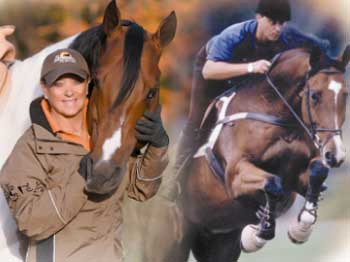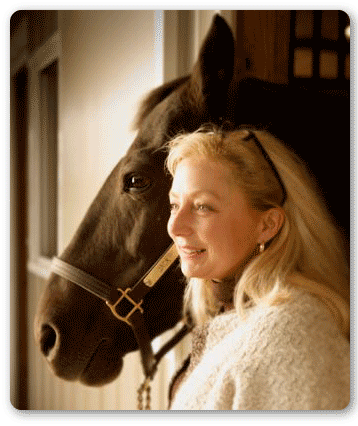Getting Back to Basics! Tips for Pasture, Stable, and Travel (Part Two)

There are so many choices when it comes to stalls for your horses. Between technical terms and various options, it can sometimes be hard to decide what is the best stall system for you and your horses. Whether you are getting ready to build new stalls in your barn, re-do your existing stalls, or just need innovative ideas for the future, this information will be sure to help you!
Lynn Palm and Debbie Disbrow both agree that a horse's stall is his home.
It needs to be spacious, well ventilated, as safe as you can make it for him, and allow for socialization. Size matters! Lynn likes her stalls to be large enough for her horses to move around and lie down. "I like 14 x 16' if I have a choice, 12x12 is most common and I would go no smaller unless the stall is for a pony." Your stalls need to fit your situation and size of your horse. Debbie adds, "You want to be sure that your stalls accommodate your horse so that they do not become cast in the stall". 12x12's are most common; however, we see many farms asking for larger stalls. Older renovated barns also need to have stalls that can fit between existing supports requiring custom sizes".
Doorways are also important and need to be large enough for the horse to get safely in and out.
Lynn suggests that doorways be at least 4-6' wide. "I like sliding doors the best, they are the safest and take up less room. Make sure any stall door is all the way open to take your horse in or out. And be sure that they are all the way closed when the horse is in the stall or out of the stall". Additionally, Debbie states "Be sure that your bar spacing is no larger than 3 1/4" - 4". This will help keep horse's hoofs and noses inside the stall helping to eliminate injury. Be sure that your stall has stay rollers at the bottom of the door, which keeps the door in place. Too much 'play in a door' is an accident waiting to happen. Horses can get heads caught and injuries can be fatal. Also, wall and post bumpers will keep your door on the track! Many stalls without bumpers will have doors falling off the track and this allows door movement even when the door is latched.
One other wonderful option for your stalls are V-door openings.
Many stalls come with the option of removing the V-door completely, or closing it completely. This option can prove to be extremely useful. "Horses like to have their heads out of a door. I have doors with the option to have an open space for the horse to have his head out, or have the stall door closed and cannot have the head out. If your horse is friendly or sensitive, they love it. If you have a territorial horse in a stall or a stallion, it is best to keep them from having the head out. Just be smart and safety is your best decision", which is good advice from Lynn. "One of our most popular options is the V-door. It allows the horse owners to have the ability to open or close the V-door. Our horses at our barn love to hang their heads out the V-door. You always know when its nap-time in the barn, all heads are out, bottom lips hang...every horse is relaxed and happy!," says Debbie. Lynn likes the solid wall partition option, "Solid walls are the safest. Horses will stay quieter and do not fuss with a horse next to them that they cannot see. If the walls have spaces between boards or rails, make sure that they are wide enough that a horse can not get a leg or foot through. Debbie agrees, "Solid walls between stalls assure that horses cannot see the horse 'next door'.
If you are concerned that your barn is 'too tight' or needs good ventilation, consider using grilled partitions that have closer spacing and you will increase ventilation in your barn.
If you have a barn where horses are coming and going, new horses in and out, your best option may be a solid wall partition." Stall mats or mattress systems also complete your barn. Debbie comments, "One of the best time savers that we installed in our barn are the stall mattress systems. They have helped to significantly save on bedding and also make cleaning the stall faster and easier. Our horses are much more rested (we see them lay down more frequently) and see major attitude changes, for the better! Our horses are definitely not as 'crabby or irritated' the day after long work outs. We have had other horses in our barn, and receive great reviews about the stall mattress systems. I can definitely say they have been paid for many times over.
We also have two horses in our barn that had to be on stall rest. With the mattress systems, the horses were comfortable and able to rest. Leg swelling was lessoned, and I just felt so much better knowing that we had done all we could to help the recuperation process", Lynn says that "Flooring is a material that is comfortable for the horse and drains well. Clay base is most common. I like rubber mats, you can use less bedding and clean the stalls quicker. Make sure you bed the stalls deep enough. If your horses lay down, this will tell you that you have enough bedding".
"Also," Debbie adds, "Be sure to account for stall mats or mattress systems when you do your stall floor layout. The stall should be able to be deep enough to accommodate the mat that you choose as well as the bedding that goes on top of it. If you don't calculate depth of your stall base to accommodate what will be on top of it, the finished stall will be too high." "Your bedding will be pushed out of your stall door and your aisle will be full of bedding. Or horses will 'walk the bedding' out of the stall when they go out, making it time consuming to remove the bedding before you close the door again. This is a big tip that can easily be missed. When you think about how often you open and close your stall doors this can become a real frustration if not thought about in the beginning layout."
One last thing to think about with your stalls are buckets.
Lynn likes buckets that cannot move around. "I like them attached and I like feed buckets low to the ground. I love deep corner feeders the best. Horses don't throw the feed everywhere. Water buckets or automatic waters- keep up high, chest level. They stay cleaner and safer for the horse. I have water near the stall door (you can water easier or look at your water). I put the feed bucket in the other corner in front of the stall, safer to feed if you go in the stall or you can have a feed door access to feed from the outside of the stall.
I like hay in the back corner on the door side.
Then I can look at my horse from the profile as he eats his hay!" Look for feeders that have rounded corners and are easy for horses to eat from. "Make sure your hand feeders are at an appropriate height so that the horses do not have to reach for their grain. There are many bucket holders available that help to keep buckets on the wall. My favorite is a swing out door with the water bucket on the door. It's easy to clean and fill!. And if you have to have a 'non-horse' person help with some chores while you are away, you know that the watering can be done from the outside of the stall. The same holds true with hay feeders that 'carousel' out and then can be locked in place" says Debbie. Also, she adds "to check your options. As always, seek out an expert in the field that will give you good choices and help you make good decisions based on your particular needs in your barn".
Most important Stall tip from Lynn: "Turn out your horses daily at least 2-3 hours a day!"
Stall material reference:
Steel
Hot-Dipped Galvanization
Electro Galvanization
Is a thinner layer of zinc that is applied by a process called electroplating. It provides excellent rust protection on the outside of steel. This protection will not last as long as hot-dipped galvanized.
Powder Coated Paint
Dipping
Spray painting
Welded stalls
Spray Painting
Please feel free to email with any questions you may have regarding stall materials, or go to "Ask Debbie."
IMPORTANT NOTE: Even with the best rust protection, with any stall system, some rusting eventually may occur. Minor touch up will be necessary at weld joints or deep scratches to keep stalls looking like new.
 Debbie has over 45 years experience with horses and equine-related businesses. She has owned, trained, boarded horses and run stables at various times in her career. She is a certified fence installer, has given balanced riding lessons, and has shown horses in Western, Western Pleasure, Trail, English, Hunter/Jumper, Fox Hunting, Hunter Trials, Dressage and driving classes. Debbie has been involved in foaling, and just about every aspect of horse ownership possible, and she welcomes your questions and comments. If you are interested in using any articles by Debbie, please send her an email.
Debbie has over 45 years experience with horses and equine-related businesses. She has owned, trained, boarded horses and run stables at various times in her career. She is a certified fence installer, has given balanced riding lessons, and has shown horses in Western, Western Pleasure, Trail, English, Hunter/Jumper, Fox Hunting, Hunter Trials, Dressage and driving classes. Debbie has been involved in foaling, and just about every aspect of horse ownership possible, and she welcomes your questions and comments. If you are interested in using any articles by Debbie, please send her an email.
